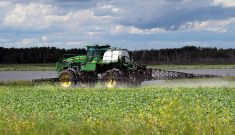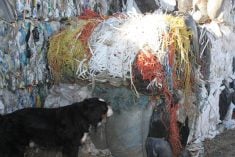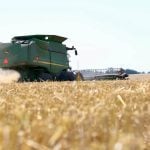CAROLINE, Alta. – Farmers may need a fresh pair of eyes when assessing water quality problems on their property.
“Most people have lived on the same farm their entire lives and do not see the solution,” said Lloyd Marshman, who farms near Rockyford, Alta., and is an environmental farm plan mentor.
Problems could result from equipment failure, depletion of the aquifer, corrosive qualities of the water or improper well design and construction.
“We have to make sure we are not contaminating our own aquifers,” Marshman said during a riparian and water quality meeting held April 26 in Caroline.
Read Also

Big Russian flax plant is another threat to Canada
A major flax crush plant is set to open in Russia. ASVA is building the facility in the city of Azov in Russia’s Rostov region.
“It is unbelievable the number of wells still being used in the middle of corrals.”
There may be straightforward solutions to well location, but sometimes there is no choice but to move the corrals. Government grants can relieve some of the expense. Problem wells can often be plugged for about $150 to $200 with reimbursement available through the environmental farm plan.
Alberta Agriculture water specialist Ken Williamson said abandoned wells present a serious threat to ground water.
There are about 59,000 farmsteads in Alberta and most have a well. The exact number of abandoned wells is unknown.
Abandoned, open wells are subject to foreign material falling in and contaminating water systems, which could include insects, mice, skunks and other small animals.
When a new well is drilled it is important to decommission the old one or poor water could continue.
Old wells with perforated casings can leak contaminants into another aquifer.
It is generally best to hire a drilling contractor to properly plug an abandoned well. Materials used to plug a well must be uncontaminated and impervious. Sand, gravel, drilling mud and fluids are not acceptable, while concrete, cement mixed with water, bentonite and clean, uncontaminated clay are acceptable.
Well pits found on many farms are a greater threat. These have been illegal in Alberta since 1993.
“Well pits are probably the worst culprits as far as contaminating wells anywhere and there are thousands of them around,” Williamson said.
They allow contaminated surface water or shallow ground water to accumulate. When this water sits in the pit, it can contaminate the aquifer by seeping around the outside of the well casing or flowing into the well. Plants and small animals are also in danger of falling into this type of construction.
If an old well pit exists, do not enter it alone or without ventilating first because toxic gas may have accumulated. Experienced drilling contractors should remove well pits.
Back flow and back siphoning from wells are other problems.
“Never install a hydrant in a casing because it is asking for trouble,” Williamson said.
For example, never fill a pesticide sprayer at such a well because the chemicals could siphon back down. The tanks should be filled in the field and away from the well.
To prevent this, an anti-siphon valve can be purchased for hydrants.
Another potential area of contamination may come from pasture pipelines set up with cross connections, which could leak at the check valves. Back-flow preventers are a good idea so that stock troughs don’t siphon back into the water system.
Valves are often submerged in the tank and without a back flow preventer, the check valve could leak. If the power goes off and the stock tank is full of water, it could potentially be sucked back and drained into the well, Williamson said.
“Some stock troughs are clean but I don’t know for sure if you want to share water with the cows.”
He suggested a dual check valve type backflow preventer.
Williamson also recommended vermin proof well caps. They seal the cap against the side of the casing to keep out rodents and insects.
Improperly abandoned seismic shot holes are another source of contamination. They are drilled 15 to 18 metres deep and there could be as many as 100 per quarter section. There is potential for material to drain into improperly sealed holes.
Seismic shot holes are plugged by installing a plastic plug with identification into the hole at a depth of not less than one metre below ground level, followed with bentonite pellets and firmly tamped borehole cuttings placed progressively upward to the surface.















